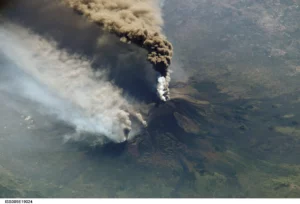
Crew aboard the International Space Station photographed the eruption of Mount Etna in Sicily in October 2002. Ashfall was reported more than 350 miles away. When it comes to explosive power, however, no eruption in modern times can compare with a super eruption – which hasn’t occurred for tens of thousands of years. (Credit: NASA)
New research suggests that sunlight-blocking particles from an extreme eruption would not cool surface temperatures on Earth as severely as previously estimated.
Some 74,000 years ago, the Toba volcano in Indonesia exploded with a force 1,000 times more powerful than the 1980 eruption of Mount St. Helens. The mystery is what happened after that—namely, to what degree that extreme explosion might have cooled global temperatures.
When it comes to the most powerful volcanoes, researchers have long speculated how post-eruption global cooling—sometimes called volcanic winter—could potentially pose a threat to humanity. Previous studies agreed that some planet-wide cooling would occur but diverged on how much. Estimates have ranged from 3.6 to 14 degrees Fahrenheit (2 to 8 degrees Celsius).
In a new study in the Journal of Climate, a team from NASA’s Goddard Institute for Space Studies (GISS) and Columbia University in New York used advanced computer modeling to simulate super-eruptions like the Toba event. They found that post-eruption cooling would probably not exceed 2.7 degrees Fahrenheit (1.5 degrees Celsius) for even the most powerful blasts.
Click here to learn more.
There are no upcoming events.
